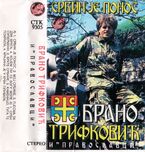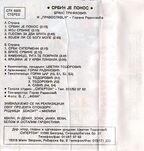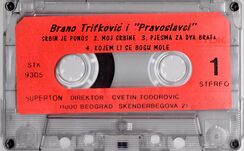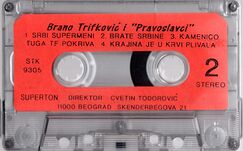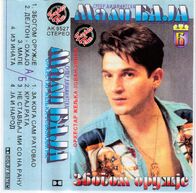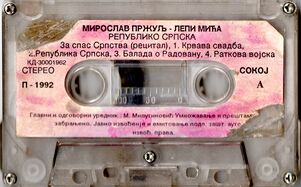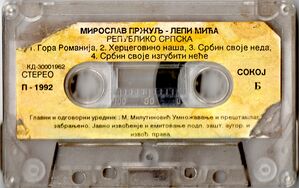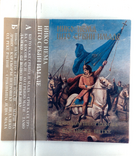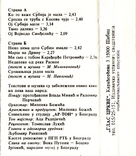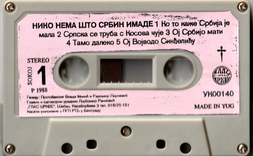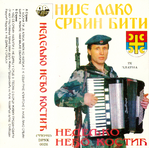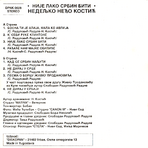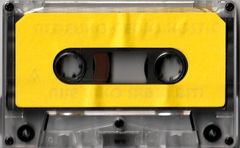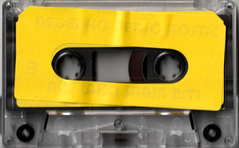Identifying fakes: Difference between revisions
Generacide (talk | contribs) (Expand this article. Still not final.) |
BalkanMapper (talk | contribs) m (Protected "Identifying fakes": VIP page ([Edit=Allow only administrators] (indefinite) [Move=Allow only administrators] (indefinite))) |
||
| (6 intermediate revisions by 2 users not shown) | |||
| Line 1: | Line 1: | ||
With cassette piracy being rampant in the 80s and 90s, fake tapes are | With cassette piracy being rampant in the 80s and 90s, fake tapes are an inevitability in war music, especially as a result of the hyperinflated economy in wartime Yugoslavia. | ||
Fake tapes ( | Fake tapes (most commonly known as "bootlegs") are somewhat of a mixed blessing for collectors. Obviously the authenticity of the material is destroyed since the tape, j-card and labels are not genuine, but it is possible to get higher quality audio from a fake tape than a real one. Some duplication houses (where albums were transferred from their masters onto cassettes to be sold in stores) had notoriously bad quality control, producing cheap tapes that while authentic, are nearly impossible to find in good condition. | ||
On the other hand, bootlegs have the possibility of being recorded onto higher quality consumer tapes (cassettes produced and sold in the consumer market for the sole purpose of home recording). That means it is possible to have a fake tape that is effectively a "snapshot" of an undegraded tape from the 90's. A bootleg could theoretically give you higher quality audio than an original version of the tape, especially if found today as many of the originals have degraded. | |||
To be clear, bootlegs are a gamble and can be wildly inconsistent, but a bootleg of a rare album is much better than not having the album at all. | To be clear, bootlegs are a gamble and can be wildly inconsistent, but sometimes a bootleg of a rare album is much better than not having the album at all. | ||
This article will provide ways of identifying bootlegs, and will show what to look for if you believe a tape is fake. | This article will provide ways of identifying bootlegs, and will show what to look for if you believe a tape is fake. | ||
== | == Identifying fakes by cover == | ||
[[File:Example of shining on a pirated tape.jpg|thumb|Here you can see the distinct shine when held angled to a light]] | [[File:Example of shining on a pirated tape.jpg|thumb|Here you can see the distinct shine when held angled to a light]] | ||
The easiest step in identifying a fake cassette is also the first thing you see, the cover. | The easiest step in identifying a fake cassette is also the first thing you see, the cover. | ||
The most obvious indicator of a fake tape is the colors of the printed J-card. Fake tapes will either have washed out | The most obvious indicator of a fake tape is the colors of the printed J-card. Fake tapes will either have washed out, very pale colors or be extremely vibrant and bright. It is also possible that blacks and other darker colors will have an odd sheen to them that contrasts from the otherwise matte paper when put under a light source. In some cases, the color will be missing entirely and you'll get a monochrome cover, or black with whatever odd color paper the cover was printed on. | ||
On most genuine cassette covers, the paper will have a general sheen across the entire card, and won't have parts that look matte while others reflect light. | On most genuine cassette covers, the paper will have a general sheen across the entire card, and won't have parts that look matte while others reflect light. | ||
Fine lines on fake tapes will often appear blurry. This is easy to notice on letters and graphics, but can also affect the main cover photo. Blur on cards is easier to notice in person, because scanning nearly any J-card can introduce blur in some areas. If you notice blur on the J-card as you hold it, that's a sign of a fake tape. | |||
Speaking of lines, you may also see odd and faded parallel lines that cut through the entire J-card, indicating it was printed on a | Speaking of lines, you may also see odd and faded parallel lines that cut through the entire J-card, indicating it was printed on a poorly calibrated inkjet printer. [[File:Zbogom-oruzje-fake-j-card-front-balkanmapper.jpg|left|thumb|A fake [[Zbogom oružje|''Zbogom oružje'']]. Notice the very vibrant colors, blurry image and excess white at the edges|302x302px]]In terms of macro photography or on a scanner level, the dots that make up the picture on a genuine J-card will look much different than the grainy, coherent texture of a card that was produced by an inkjet. The text and logos on real J-cards will often be much sharper than pictures, so if your letters don't look clear in your scanner, you may have a fake. | ||
Since fake J-cards were cut by hand most of the time, it is not rare to see white edges of blank paper around the perimeter of the card. In some cases, this can make the card too big for the case giving a crinkled or bent look when putting it back in. There are also imperfect cuts in which there are missing parts of the cover due to being cut at an odd and inconsistent angle. Improper borders don't necessarily guarantee a tape is fake, but they are an additional feature to look for if you are already noticing some of the aforementioned signs. | |||
The last obvious indicator is when the design of the cover changes. While some authentic copies did have alternate covers between reissues of the same album, it was a fairly rare practice outside of releases by a foreign distributor, releases by state media labels, and reissues between different label which was already uncommon to begin with. Another dead giveaway in this regard is when the back off a J-card is completely blank with no text. Very rarely genuine albums have been found without text on the back of their J-cards, but these are usually obscure releases by smaller independent labels and not by any prominent labels like RTS, Jugodisk, and Jugoton. | |||
The | == Cassettes == | ||
[[File:Brano-Trifkovic-Srbin-je-ponos-fake-cassette-side-a-balkanmapper.jpg|thumb|302x302px|A fake [[Srbin je ponos|''Srbin je ponos'']]. The cassette itself has an entirely different label than any genuine copy. Also the printing of the blank TDK tape used for the bootleg can be seen to the right]] | |||
As cassette labels are hard to scan, bootlegs often lack sharpness and detail. This can be seen in letters having gaps in them or by being very blurry. To avoid that, bootleggers sometimes opt to remake the tape labels, creating a new design. These ones are very obvious to spot as they differ substantially to known originals. They can lack rights texts, relevant information like publishers, logos, catalog numbers and can use different typefaces or side indicators. In some cases bootleggers will have their own sophisticated label templates for the cassette labels. For example some [[Slušajte dok vas ne uhvate za .....|Srpski Talibani]] bootlegs have an "In Moorton Benson" text with a logo of two seahorses over a fake catalog number, a template used for many bootlegs of various albums. The color is also a big indicator as most genuine releases have labels printed on white paper while a majority of bootlegs will print genuine graphics on bright colors like red or yellow. | |||
The cassette used for bootlegs can often vary. Very rarely they are recorded over actual blank cassettes from factories, making them look more official. A lot of times it will be recorded over a blank consumer cassette. This will be visible, for example when shining a flashlight at the cassette and seeing the pad printed text of the blank cassette (logos, side indicator, etc.) coming through the paper labels. If that is the case, the tape length can also exceed the albums length, creating way too much blank space with just noise after the songs of the side end. It is also common for bootleg cassettes to be taped over other official releases. This can either be seen by bootleg labels being glued on the previous labels, or over a previously pad printed release. | |||
== Hall of Shame == | |||
Here we will showcase some of the bootleg tapes that have wound up in our collections, to help show you more examples so you know what to look out for. | |||
{{Multiple image | |||
| total_width = 800 | |||
| image1 = Brano-Trifkovic-Srbin-je-ponos-fake-j-card-front-balkanmapper.jpg | |||
| image2 = Brano-Trifkovic-Srbin-je-ponos-fake-j-card-back-balkanmapper.jpg | |||
| align = none | |||
| image3 = Brano-Trifkovic-Srbin-je-ponos-fake-cassette-side-a-balkanmapper.jpg | |||
| image4 = Brano-Trifkovic-Srbin-je-ponos-fake-cassette-side-b-balkanmapper.jpg | |||
| header = Brano Trifković - Srbin je ponos | |||
| footer = Notes | |||
*Recorded over a 1990 TDK cassette | |||
*White on the bottom of the J-card | |||
*Blurry cover | |||
*Saturated colors | |||
*Different cassette label | |||
}}{{Multiple image | |||
| total_width = 800 | |||
| image1 = Zbogom-oruzje-fake-j-card-front-balkanmapper.jpg | |||
| image2 = Placeholder.png | |||
| align = none | |||
| image3 = Placeholder.png | |||
| image4 = Placeholder.png | |||
| header = Baja Mali Knindža - Zbogom Oružje | |||
| footer = Notes | |||
*Blurry cover | |||
*Heavily saturated colors | |||
*Different cassette label | |||
}}{{Multiple image | |||
| total_width = 800 | |||
| image1 = Lepi-Mica-Republiko-Srpska-fake-front.jpg | |||
| image2 = Lepi-Mica-Republiko-Srpska-fake-side-a.jpg | |||
| align = none | |||
| image3 = Lepi-Mica-Republiko-Srpska-fake-side-b.jpg | |||
| header = Lepi Mića - Republiko Srpska | |||
| footer = Notes | |||
*Cover printed with an ink jet printer | |||
*Back of the J-card blank | |||
*Very sticky and thick cardstock | |||
*Very blurry cover | |||
*Genuine cassette label design, but with different colors | |||
}}{{Multiple image | |||
| total_width = 800 | |||
| image1 = NikonemaštoSrbinimade-Fake-J-card-front-RA20K.png | |||
| image2 = NikonemaštoSrbinimade-Fake-J-card-back-RA20K.png | |||
| align = none | |||
| image3 = NikonemaštoSrbinimade-Fake-side-A-RA20K.png | |||
| header = Niko nema što Srbin imade | |||
| footer = Notes | |||
*j-card is made with two pieces of paper | |||
*Cover is smaller than usual and printed on laminated cardstock | |||
*The cover design is creased in the incorrect spot and is the incorrect size | |||
*Print quality is indicative of a commercial printer | |||
*Cassette labels look messy as if photocopied from an actual cassette | |||
*Unconventional cassette shell and label colors. | |||
| image4 = NikonemaštoSrbinimade-Fake-side-B-RA20K.png | |||
}}{{Multiple image | |||
| total_width = 800 | |||
| image1 = NijelakoSrbinbiti-fake-j-card-front-RA20k.png | |||
| image2 = NijelakoSrbinbiti-fake-j-card-back-RA20k.png | |||
| align = none | |||
| image3 = NijelakoSrbinbiti-fake-side-A-RA20k.png | |||
| image4 = NijelakoSrbinbiti-fake-side-B-RA20k.png | |||
| header = Nedeljko Neđo Kostić - Nije lako Srbin biti | |||
| footer = Notes | |||
*Vibrant colors | |||
*Camo is a vibrant green when it should be muted | |||
*Diskopan has a yellow outline with missing parts of its border | |||
*j-card is made of paper | |||
*Label is in Latin instead of Cyrillic and is noticeably faded | |||
}} | |||
Latest revision as of 02:17, 3 February 2025
With cassette piracy being rampant in the 80s and 90s, fake tapes are an inevitability in war music, especially as a result of the hyperinflated economy in wartime Yugoslavia.
Fake tapes (most commonly known as "bootlegs") are somewhat of a mixed blessing for collectors. Obviously the authenticity of the material is destroyed since the tape, j-card and labels are not genuine, but it is possible to get higher quality audio from a fake tape than a real one. Some duplication houses (where albums were transferred from their masters onto cassettes to be sold in stores) had notoriously bad quality control, producing cheap tapes that while authentic, are nearly impossible to find in good condition.
On the other hand, bootlegs have the possibility of being recorded onto higher quality consumer tapes (cassettes produced and sold in the consumer market for the sole purpose of home recording). That means it is possible to have a fake tape that is effectively a "snapshot" of an undegraded tape from the 90's. A bootleg could theoretically give you higher quality audio than an original version of the tape, especially if found today as many of the originals have degraded.
To be clear, bootlegs are a gamble and can be wildly inconsistent, but sometimes a bootleg of a rare album is much better than not having the album at all.
This article will provide ways of identifying bootlegs, and will show what to look for if you believe a tape is fake.
Identifying fakes by cover
The easiest step in identifying a fake cassette is also the first thing you see, the cover.
The most obvious indicator of a fake tape is the colors of the printed J-card. Fake tapes will either have washed out, very pale colors or be extremely vibrant and bright. It is also possible that blacks and other darker colors will have an odd sheen to them that contrasts from the otherwise matte paper when put under a light source. In some cases, the color will be missing entirely and you'll get a monochrome cover, or black with whatever odd color paper the cover was printed on.
On most genuine cassette covers, the paper will have a general sheen across the entire card, and won't have parts that look matte while others reflect light.
Fine lines on fake tapes will often appear blurry. This is easy to notice on letters and graphics, but can also affect the main cover photo. Blur on cards is easier to notice in person, because scanning nearly any J-card can introduce blur in some areas. If you notice blur on the J-card as you hold it, that's a sign of a fake tape.
Speaking of lines, you may also see odd and faded parallel lines that cut through the entire J-card, indicating it was printed on a poorly calibrated inkjet printer.
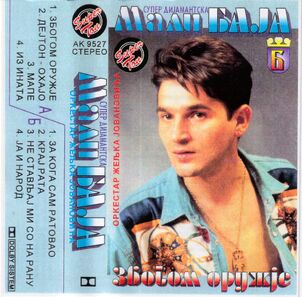
In terms of macro photography or on a scanner level, the dots that make up the picture on a genuine J-card will look much different than the grainy, coherent texture of a card that was produced by an inkjet. The text and logos on real J-cards will often be much sharper than pictures, so if your letters don't look clear in your scanner, you may have a fake.
Since fake J-cards were cut by hand most of the time, it is not rare to see white edges of blank paper around the perimeter of the card. In some cases, this can make the card too big for the case giving a crinkled or bent look when putting it back in. There are also imperfect cuts in which there are missing parts of the cover due to being cut at an odd and inconsistent angle. Improper borders don't necessarily guarantee a tape is fake, but they are an additional feature to look for if you are already noticing some of the aforementioned signs.
The last obvious indicator is when the design of the cover changes. While some authentic copies did have alternate covers between reissues of the same album, it was a fairly rare practice outside of releases by a foreign distributor, releases by state media labels, and reissues between different label which was already uncommon to begin with. Another dead giveaway in this regard is when the back off a J-card is completely blank with no text. Very rarely genuine albums have been found without text on the back of their J-cards, but these are usually obscure releases by smaller independent labels and not by any prominent labels like RTS, Jugodisk, and Jugoton.
Cassettes
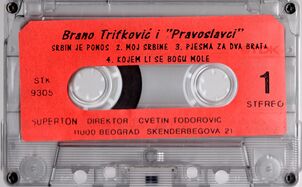
As cassette labels are hard to scan, bootlegs often lack sharpness and detail. This can be seen in letters having gaps in them or by being very blurry. To avoid that, bootleggers sometimes opt to remake the tape labels, creating a new design. These ones are very obvious to spot as they differ substantially to known originals. They can lack rights texts, relevant information like publishers, logos, catalog numbers and can use different typefaces or side indicators. In some cases bootleggers will have their own sophisticated label templates for the cassette labels. For example some Srpski Talibani bootlegs have an "In Moorton Benson" text with a logo of two seahorses over a fake catalog number, a template used for many bootlegs of various albums. The color is also a big indicator as most genuine releases have labels printed on white paper while a majority of bootlegs will print genuine graphics on bright colors like red or yellow.
The cassette used for bootlegs can often vary. Very rarely they are recorded over actual blank cassettes from factories, making them look more official. A lot of times it will be recorded over a blank consumer cassette. This will be visible, for example when shining a flashlight at the cassette and seeing the pad printed text of the blank cassette (logos, side indicator, etc.) coming through the paper labels. If that is the case, the tape length can also exceed the albums length, creating way too much blank space with just noise after the songs of the side end. It is also common for bootleg cassettes to be taped over other official releases. This can either be seen by bootleg labels being glued on the previous labels, or over a previously pad printed release.
Hall of Shame
Here we will showcase some of the bootleg tapes that have wound up in our collections, to help show you more examples so you know what to look out for.
- Recorded over a 1990 TDK cassette
- White on the bottom of the J-card
- Blurry cover
- Saturated colors
- Different cassette label

